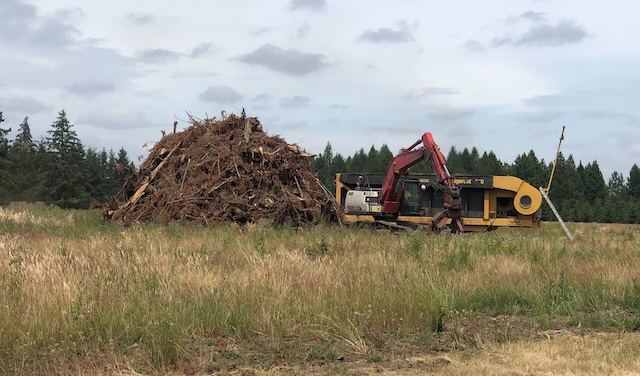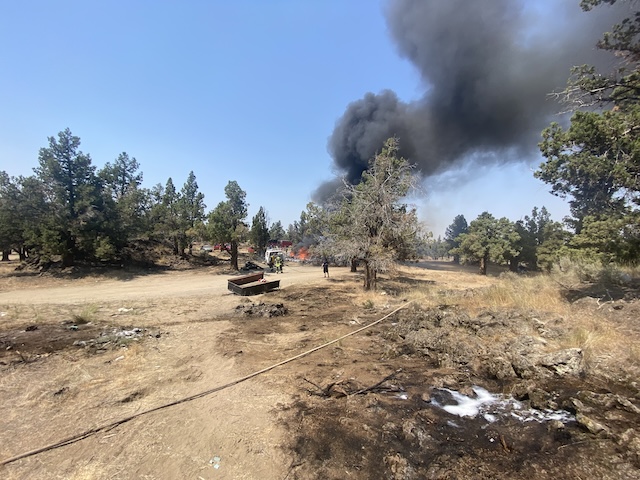‘Forever chemicals’ persist in Bend’s Copperstone Well
Published 6:45 am Tuesday, April 29, 2025

- Drexell Barnes, water quality and laboratory services manager with city of Bend, describes the Copperstone Well in Bend. (Dean Guernsey/The Bulletin)
Elevated levels of so-called forever chemicals have been detected in recent testing of a well in northwest Bend. But the city of Bend still has several years to reduce levels of the chemical to comply with state law.
The Copperstone Well, tested most recently on April 8, had a positive detection of PFOA (perfluorooctanoic acid) at 22.5 parts per trillion, according to Drexell Barnes, the water quality and laboratory services manager for the City of Bend. Previously the highest concentration of PFOA that had been detected was 15.3 parts per trillion.
Tests are being conducted on a bi-monthly basis at the Copperstone Well next to Quail Park in north Bend. The city is currently evaluating how best to mitigate the “forever chemicals,” so-called because they do not break down in the environment.
Trending
Forever chemicals are also known as PFAS, which stands for per- and polyfluoroalkyl substances. PFOA is a specific type of PFAS.
The chemicals can be found in non-stick pans, waterproof clothing and food packaging such as microwave popcorn bags. They are also found in firefighting foam, a common product used for training on military bases. A handful of states (New York, California and Minnesota) have banned the sale of garments that contain PFAS chemicals.
Studies link these chemicals to thyroid problems, cancer and child development issues, especially if exposed at levels higher than the Environmental Protection Agency’s lifetime health advisory of 70 parts per trillion. A lifetime health advisory is a non-enforceable guideline set by the EPA that identifies the maximum concentration of a contaminant in drinking water that is not expected to cause adverse health effects over a lifetime of daily exposure, including for sensitive populations such as children and pregnant women.
First detected
The city of Bend says it cannot pinpoint the exact source of PFAS contamination at Copperstone Well.
“More analysis and testing could help narrow down possible contamination, but due to the ubiquitous nature of these chemicals, tracing them is extremely challenging,” said Barnes.
The city first detected the forever chemicals in its water supply in May 2023 when it tested drinking water for 29 PFAS chemicals. Eight of the nine drinking water sources, including the Bridge Creek surface water source, found no detectable amount of PFAS. Four PFAS chemicals were identified in the Copperstone Well.
Trending
While the recent testing revealed a slight increase of the chemicals at the Copperstone Well, the amount detected is deemed miniscule — one part per trillion is equivalent to one drop of water in 20 Olympic sized swimming pools.
Still, the city isn’t taking any chances with the well — for now, Copperstone Well water is monitored but not used for the city water supply.
Complying with law
Barnes says Bend is planning to mitigate PFAS contamination at Copperstone Well so it can be in compliance with state requirements when they become enforceable in 2029.
In order to be in compliance, the level of PFAS chemicals must be 4 parts per trillion. Compliance also requires initial monitoring to occur by 2027, along with informing the public of PFAS levels.
So far, sampling at the Copperstone Well has been voluntary. Official monitoring for compliance is planned for 2026, said Barnes. Even if the city can reduce the PFAS levels to 4 parts per trillion, that doesn’t mean the well can be switched on.
“It would take several tests and lots more time to be sure that the levels are down,” said Barnes.
If the well is used again, officials say it’s not clear if the water from Copperstone would be put into the drinking supply. Barnes says the well would more likely be available for urgent needs such as firefighting. Testing and monitoring would also continue, he said.
While officials continue to test the Copperstone water, they are also waiting for resolution of a settlement claim against 3M and Dupont, corporations that spent decades producing PFAS chemicals for use in a variety of products.
“Our claim has been processed and claim administrators are currently determining payment amounts and schedules. A final payment amount is unknown at this time,” said Jacob Larsen, a spokesperson for the City of Bend.
For more information on PFAS chemicals and how the city monitors them, view the city’s water quality page at: bendoregon.gov/waterquality










